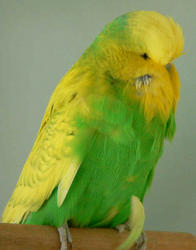 |
|
Before getting a bird it is necessary to decide on the most suitable species. The easiest for most families is one of the smaller birds, such as a budgerigar, cockatiel or lovebird.
The larger species such as the cockatoos can be very demanding, very vocal and very destructive. Many councils prohibit the keeping of the larger parrots due to noise.
Australia has many beautiful coloured native species which are available in pet stores, but not all are easy to keep as pets. Some, while they make entertaining pets, require special food - e.g, lorikeets which require a nectar substitute and as a result of their semi-liquid
diet they have semi-liquid faeces which makes keeping their surroundings clean much more difficult. Permits may also be required from the state government to keep some native species of birds.
When considering the type of bird for your household, consider also the size and cost of the cage that will be required. Purchase the largest cage that you can afford as all birds appreciate as much room as possible.
When purchasing your bird, buy from a breeder or store where the cages are clean and the
birds are bright and happy. Never feel sorry for a bird and buy it out of pity because it is sick.
Most birds showing signs of illness are seriously ill and will probably die within a few days. If you already have birds at home you are likely to spread a disease to your own birds.
Newly purchased birds should be kept away from your other birds for several weeks until you are sure they are not harbouring a disease.
While it is true that "babies" just out of the nest are likely to be easiest to train be sure that the baby bird is fully weaned before you purchase it.
A healthy bird will have tight, clean and glossy feathers. An ill bird will fluff the feathers and will often have soiled feathers in the area under the tail. |